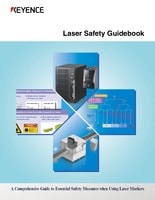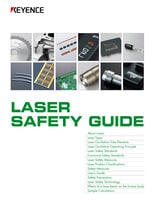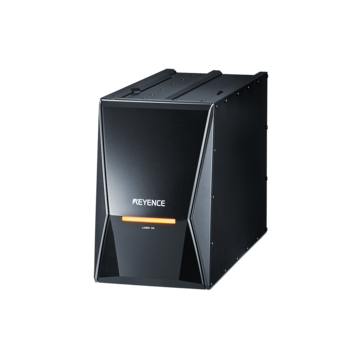Laser Marking Systems / Laser Markers
Understanding Laser Classes and Laser Safety
-
Tags:
- Laser Marking , Aerospace , Food and Pharmaceutical
Since the invention of the laser in 1960 by Theodore Maiman, lasers have been used across industries in scientific processes, manufacturing, and for education. Laser beams can cut, mark, drill, and clean even the toughest materials, illuminate areas, and even conduct medical procedures.
Although laser technology has evolved and is widely used, certain laser wavelengths are hazardous to operate and require protocols for ensuring safety. In this blog, we’ll define each laser class and the safeguards associated so you can be an informed laser operator.
Laser Classes Explained
Lasers can be dangerous, potentially damaging eyes, skin, and workplaces. Because of this, regulatory institutions within countries and international organizations identified tiers, known as laser classes, depending on wavelength and exposure effects. These laser classes identify eye, skin, and workplace hazards related to the wavelength.
Although these laser classes slightly differ across institutions, this blog will reference the international standard established by the International Electrotechnical Commission (IEC). This standard, called the IEC 60825-1, categorizes lasers into four classes with four subcategories. The IEC 60825-1 was created to provide international laser safety standards for industries, military, research and development, and higher education.
We’re here to provide you with more details.
Reach out today!

Class 1
Class 1 is the safest of the laser classes. Lasers in this class do not threaten eyes, skin, or combustibles as a fire hazard. Even with optical instruments, these laser devices are still safe to interact with without protection.
There are two reasons why Class 1 lasers are non-threatening. First, these lasers have low output power with beams less than .39mW. Not only are these beams extremely low, but they also are usually enclosed in a working area or machine. That said, lasers in higher laser classes (particularly 4) can be identified as Class 1 lasers if they follow enclosure precautions that protect individuals from coming in contact with the laser.
Examples of Class 1 lasers are laser printers or DVD players.
Class 1M
Within Class 1, there’s a subcategory titled Class 1M. Class 1M is almost identical to Class 1, with the difference being that Class 1M is dangerous to the eyes if viewed with an optical instrument. This laser classification includes wavelengths between 302.5 nm to 4,000 nm.
Examples of Class 1M lasers include laser diodes, fiber communication systems, and speed meters.
Discover more about this product.
Click here to book your demo.

Class 2
Class 2 lasers are visible light lasers that are generally safe but could cause eye damage if mishandled. These lasers emit radiation from 400 nm to 700 nm and are visible to the naked eye. Like Class 1 lasers, this laser classification is safe to look at with an optical instrument.
Eye trauma is possible from staring directly into a Class 2 laser. But with this being said, the human eye uses blinking as a protective reaction to Class 2 lasers. An individual would only be harmed if they purposefully looked into a Class 2 laser and resisted the blinking urge. This natural protective reaction is the reason for Class 2 laser’s lower laser classification, as it doesn’t usually cause harm.
Examples of Class 2 are laser pointers like ones used in a classroom or for a demonstration.
Class 2M
Class 2M is a subcategory of Class 2 lasers. This laser classification is similar to Class 2 but is hazardous if looked at with an optical instrument. The self-protective blinking response is not quick enough to protect from the retina-absorbing Class 2M lasers.
We’re here to provide you with more details.
Reach out today!

Class 3
Unlike Class 1 and 2, there is no “Class 3”. Instead, there are two laser class 3 categories: Class 3R and Class 3B.
Class 3R
Class 3R lasers are continuous wave (CW) intermediate lasers between 1-5mW. These beams are visible to the eye and are also frequently used for laser pointers; however, the strength of the beam overpowers an individual’s protective blinking response. Because of this, Class 3R lasers require a laser safety warning label because eyes can immediately be harmed by looking directly into the laser beam instead of at an angle.
Class 3R lasers should not be looked at with an optical instrument either, as that will cause immediate eye trauma.
Class 3B
Class 3B lasers are lasers that use intermediate power from either 5-500mW CW or pulsed 10J/cm2. Operating a Class 3B laser incorrectly can result in eye damage or skin burns. Because of this, Class 3B lasers require laser safety goggles and laser safety warning labels.
An example of Class 3B lasers is 3D printers.
Discover more about this product.
Click here to book your demo.

Class 4
Class 4 is the most hazardous laser classification. This category has the potential for skin, eye, and fire hazards with 500mW CW or 10J/cm2 pulses.
This strong output is used for laser marking, welding, cleaning, and cutting. Any Class 4 laser has laser safety warning labels cautioning against interaction between eyes, skin, and flammable materials or gasses. To operate these lasers, technicians need goggles and/or body suits for protection.
Still, although the strength of the laser is hazardous, Class 4 lasers can be minimized to Class 1 with proper enclosure techniques. Even as a Class 4 laser, safeguards should keep you protected from potential hazards.
We’re here to provide you with more details.
Reach out today!

How Laser Classes Factor into Laser Safety
Each class of lasers specifies the safety of using a certain wavelength or type of laser. When considering operating or using a laser, considering the class it’s in is essential before operating. Treating a Class 4 laser like a Class 1 laser will harm your skin, body, and workspace.
Despite these safety considerations, there is no need to fear lasers. Rather, understand their power and act accordingly. As a laser user, you must establish and implement safety measures and ensure that all operators are adequately trained.
These laser classes specify what equipment and precautions are needed to mitigate harm. Always take warnings seriously and invest in proper protocols.
Discover more about this product.
Click here to book your demo.

Using KEYENCE’s Lasers
KEYENCE’s laser marking machines are Class 4 lasers because of their wavelength and ability to process materials. Although they are Class 4, there are protocols that can establish the laser as Class 1 following the right enclosure or equipment practices, and the KEYENCE support team can help guide you in the right direction.
For more detailed information on keeping you and your colleagues safe with our laser marking machines, review our Safety and Standards page.
We’re here to provide you with more details.
Reach out today!




![LASER TECHNICAL GUIDE [An Introduction]](/img/asset/AS_69962_L.jpg)

